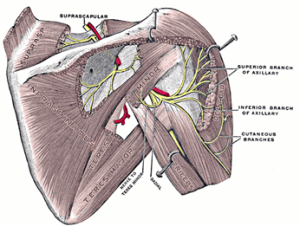Description
Axillary nerve injury can occur following shoulder dislocation or humerus fracture. These may be caused by over stretching the shoulder joint or direct trauma to the area (Figure 1).

Figure 1. Drawing showing the anatomy of the axillary nerve at the shoulder, posterior view. Injuries to this part of the body can injure the axillary nerve, resulting in axillary neuropathy.
Diagnosis
The diagnosis of axillary nerve injury is initially made on neurological examination. Weakness and atrophy of the deltoid muscle and numbness on the side of the shoulder are the classic findings. Electrodiagnostic studies are helpful to confirm the diagnosis, and to help rule out other disorders such as brachial plexus or other nerve injuries.
Treatment
In many cases, axillary nerve injury will heal on its own. This may take several months. During that time, it is important to do physical therapy to maintain flexibility across the shoulder joint.
If after several months, the weakness does not improve, then surgery to treat the nerve injury is indicated. In this operation, a branch of the radial nerve (which is not affected by the axillary nerve injury) is taken from the triceps muscle and transferred to the axillary nerve, where it eventually grows into the deltoid muscle (Figure 2). This allows the deltoid muscle to start working again over time. Recovery can be a lengthy process, lasting over a year in many cases.
